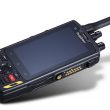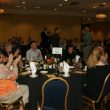A CANDLE IN THE DARKNESS
An old joke says, “The light at the end of the tunnel may be an oncoming train.” However, in railroad communications, tunnels are no laughing matter.
Railroad radio systems are vital to train movement and control, switching operations, equipment-failure detection and emergency response. Federal Railroad Administration radio communications rules require the capability to transmit and receive between any location in a railway system and the control center. Not only must trains be in constant contact, but support crews and maintenance vehicles working on any section of track must also be able to call for assistance or receive advisories via radio. (See MRT September 1999 and May 2000.)
Trains passing through tunnels briefly lose their critical links to central dispatch in what is obviously a high-risk environment. Communications from one end of the train to the other can also be interrupted. Constant communications between the lead engine and the rear engine is crucial to safe and efficient locomotive operations.
Most railroad tunnels were blasted decades ago when the rail lines were established, long before radio communications was a consideration. Mandatory radio contact can be problematic, even in a short tunnel.
Burlington Northern Santa Fe Railway, at an experimental site in Wyoming, has implemented a solution to this problem. After 11 months of operation, the first communications system designed to transmit broadband wireless signals using fiber-optic technology in tunnels has been deemed a success by BNSF. The system is also applicable to similarly difficult communications environments, such as buildings and subterranean structures.
The system, developed by RF LightLink, Overland Park, KS, was installed in a 3,318-foot tunnel in Guernsey, WY, in July 2000. The Guernsey BSNF rail yard is near the North Platte River in Eastern Wyoming, about 15 miles from Ft. Laramie. The Guernsey tunnel caused difficulties with the distributive power systems of locomotives passing through it.
Prior to this installation, communicating inside and from the tunnel was impossible. This situation created headaches for trainmasters and roadmasters. The DP system had to be isolated (operator decommissioned) so it would not operate in this area. If the system failed to communicate, the train would probably be stopped. The end unit could no longer receive a signal, and someone would have to go back and restart the unit.
Because the east end of the tunnel feeds directly into the Guernsey rail yard, this is not the best place to have a DP or end-of-train system inoperative. (EOT systems are why trains seldom have the traditional red caboose anymore. The EOT device is radio linked to the locomotive to give the crew systems-status information. Railroads use several frequencies: voice analog FM networks at VHF highband (160MHz, UHF [450MHz-475MHz] for two-way EOT devices and 900MHz for electronic train-control applications.)
The solution to the communications interruption problem was developed under an experimental, nationwide, five-year FCC license granted to RF LightLink’s parent company, Prodigy Marketing. Randall W. Crawford, the RF LightLink concept’s originator, is pleased with the new application.
“We feel that the system has been in operation long enough now that any problems would have become evident,” Crawford said. “We are excited about the opportunities this new application represents to the many businesses that can benefit from this type of service.”
BNSF, through its consulting systems engineer, Robert C. Leedham, signed on to be the first to adopt the new technology after a successful beta test at BNSF facilities in Kansas City, MO.
“Until now, we have had to depend on a ‘leaky’ coax type of communications system with narrowband capability, which does not meet our needs in these critical environments,” Leedham said. The new system, he said “enables us to address a much wider range of communications frequencies with greater reliability than we could previously with existing solutions at a comparable cost.”
The concept behind the new system is the distribution of RF signals from mobile units operating in-tunnel (or in-building) to the outside environment. The system is transparent to the mobile units operating in-tunnel and to the base station and mobile units in the outside environment communicating with the in-tunnel radios. A fiber-optic cable system, connected to a series of “operating nodes,” is placed in the tunnel.
At each end of the tunnel is a “donor node” that receives signals from outside the tunnel. The donor node converts RF energy into light energy that can be transmitted throughout the tunnel via the fiber-optic cable and the series of operating nodes. These nodes, spaced about 1,000 feet apart, function as transceivers, converting and transmitting signals received by the donor node to the tunnel environment. They also convert and transmit signals from the mobile units operating in the tunnel to broadband antennas located at the tunnel entrances. The RF energy is transmitted from the broadband antenna into the open environment with no change in power, frequency, bandwidth or modulation.
The broadband antennas for the Guernsey demonstration project were placed at a HAAT of about 45 feet. Although they can cover 100MHz to 1GHz, the antennas are being used in this application for 160MHz and 460MHz systems.
The RF LightLink system is designed to receive and transmit frequencies for virtually all forms of wireless communications, including cellphones, pagers, trunking, digital and more. The units are protocol-independent, meaning that regardless of the frequency band or modulation scheme used in the outside environment, “send” and “receive” modes will operate the same way inside the tunnel or subsurface area.
BNSF’s tests showed the system to be highly efficient. “In tests of bit-error rates on the RF LightLink system, more than 10,000 different strings of 100,000 characters each were sent and received with zero errors,” Leedham said.
Leedham handpicked a team of 28 technicians to conduct the installation. This team of specialists, led by Project Manager Mark Wentland and Project Leader Ray Southworth, included telecom tower foremen, telecom tower men and electronics technicians. The installers worked diligently as a team without injury or mishap. This is notable because they also had to work fast — in two- to four-hour intervals between train operations. Still, the installation was completed in seven days, with an additional three days for tweaking the system.
Modified railcars were used as work platforms to help the installers to run cable and to set up multiple transmitter locations. Specially designed stainless-steel clips were used to simplify installment of the cable systems. A temporary lighting system, supported by a 35kW generator, was also required.
Once the hardware was installed, the next step was to run cable, 48Vdc cable first and then the fiber-optic cable. Three fiber-optic cable transceivers were then placed in the tunnel. These units receive RF signals off air, modulate them onto fiber-optic cable and then route the signals to all units inside and outside of the tunnel. Fiber-optic cable takes a mere 3ns to send a signal 1km, and demodulating the RF takes only 500μs.
The antennas were installed at the same height as the antennas mounted on the train. This promotes more signals getting to the antennas. There are two antennas per transceiver. Keeping the TX and RX separate allows faster transmission and signal reconstruction. If a transmission is received by a transceiver (node) in the tunnel, the signal is sent to all nodes and through the fiber-optic cable, and the units transmit all at the same time.
The east-end site had yagi antennas pointing directly into the rail yard. This allowed communications from inside of the tunnel with portables or mobiles. This was not available before the system was installed. In fact, 30W mobiles would not talk inside the tunnel before the new system was installed. Once the installation was completed, a 5W portable could talk to the yardmaster from anywhere inside of the tunnel or at the openings of the tunnel. Yagi antennas were also placed at the west-end site to provide communications to the outside world from inside the tunnel, or vice versa.
The system is alarmed at each location, sending back alarm status to the central unit. The alarm circuit will sense power levels and create an alarm condition if the levels fall below the programmed minimum. The system is constantly monitoring the RF, fiber-optic and power inputs for possible faults. If power is dropped for whatever reason, the unit automatically switches to battery backup. The battery backup lasts as long as three days. In addition, when an alarm condition is sensed, a blue-flashing strobe activates at the individual node.
The entire system will continue to operate, even if one transceiver is inoperative. The fiber is sent from unit to unit in daisy-chain fashion so that any one unit can be taken out of the system and the entire system won’t be compromised.
“With RF LightLink, we strive to have a system that is balanced and use placement of transceivers in areas needed — pristine placement, not using brute force or high power,” Crawford said. “Fiber-optic losses are in the 0.23dB arena, per kilometer. Essentially, anything transmitted can be received and modulated onto fiber-optic and then retransmitted as an RF signal into an area of desired coverage.” RF LightLink submitted a patent application for the system in December of 1999.












